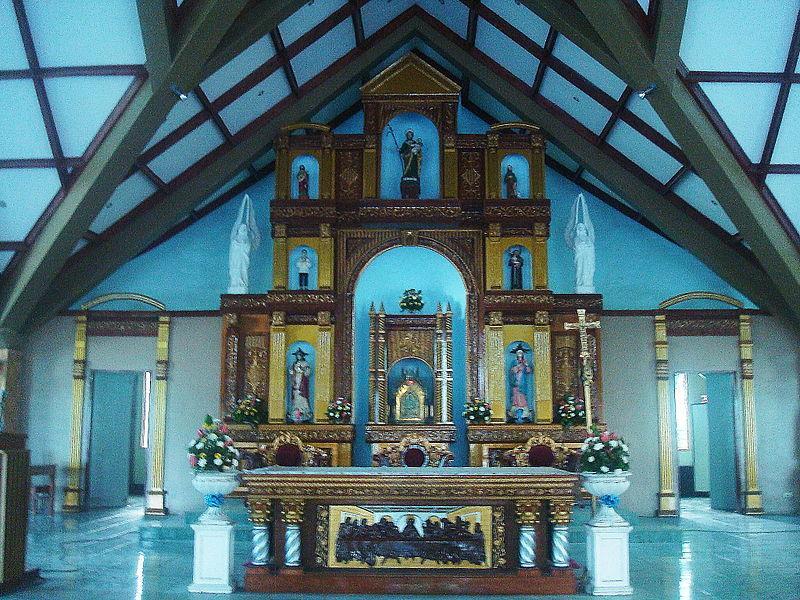
St. Joseph Parish of Dagami
Dagami is one of the many towns in Leyte that has contributed much to the growth of the province. From its natural wonders, to its bountiful agriculture, to its irresistable culinary delicacies, Dagami continues to be a vital land of potential for Leyte.
Etymology – Dinagami to Dagami!
Locals indicate the name "Dagami" first arose during a confrontation between a group of Spaniards and a group of farmers during the Spanish colonial period:
“One harvest season, Spanish soldiers inquired a group of men and women harvesting rice nearby the name of the community that was a few meters away. The natives thought that they were asking for a definite term for the field after rice had been harvested and answered, "Dinagami, a Senior." The Spanish had such difficulty in pronouncing Dinagami that the natives ridiculed them. Having felt insulted, one of the civil guards shouted angrily in Spanish, "Dagami or Dawian makes no difference! This place is Dagami, Dagami, Dagami! You Indios! What a queer language you speak." From then on, Dagilan was changed to Dagami by the village folk who thought the name was most suited for the place.”
Economy
Rice and coconut production is the primary economic source of income for the townsfolk. Aside from farming, food processing is another source of income for the town of Dagami. Recently, upsurges in labor export (OFWs) have contributed to remittances of income from abroad. Commercial businesses are limited to retailing while trading activities are limited to rice and copra trading.
Despite popularity of its indigenous food product, the binagol, Dagami has yet to maximize its economic potentials, such as creation of labor during its production line, income to be generated from sales, and revenue for the local government in terms of income taxes. Chief economic products of the municipality are the following:
- Production of copra - a by-product of coconut tree fruit is the main industry of the townfolks. The growth of local economy is highly dependent on copra production due to price fluctuation in the market of its by-products such as oil, dissicated coconuts, and other raw materials made from leaves, bark, and the coconut fruit itself.
- Rice farming is the second source of livelihood for the people of Dagami. Almost half of the land area is planted with different variety of rice stocks. It is likewise the second most traded product in the town next to copra.
- "Tuba", is a well-known drink to Leyteños. Aside from copra production, the gathering of this product from coconut sap is another source of livelihood for Dagami-ons. "Tuba" is then traded in the market by local entrepreneurs but often sold directly by the gatherers.
Binagol, the local delicacy
The town of Dagami is known for its local delicacy, the "Binagol," a sweet, glutinous mixture of cassava, legume crop and other ingredients cooked with filling made of sugar, coconut and milk placed in a coconut shell or "bagul" and wrapped with banana leaves. Dagami also has other local delicacies such as "sagmani", and "moron".
The "binagol" is sold in the city market primarily in Tacloban City while some reach the international markets.
Tourism – Its Rivers and Mountains
- The town of Dagami is traversed by many rivers and streams upland. The biggest river is Panda River which cuts across the town's northeast section. Sawahon River is among its tributaries which is also joined up stream by its major tributaries such as Hilabago River, Kababatuan Dako (Greater Stones) River and Kababatuan Guti (Smaller Stones) River.
During the rainy season, when these rivers rise, the downtown or Poblacion is flooded causing damages to property. A river dike which is also a diversion road was built to protect the town center. But as the river rises higher than the dike, it overflows causing more water to flood the town center.
- The majestic Mount Amandiwing located near Dagami is the highest peak in Leyte. The imposing mountain is a protected natural park where wildlife such as pigs, deers and monkeys are hunted by local hunters despite by a local ban. During the 1960s, a logging concession was permitted to cut its virgin forests but the concessionaire never replanted trees. Locals exploited the situation by farming the logged area and creating coconut plantations.
The mountain is best viewed from the town proper. On approach to the town proper, the mountain is an imposing majestic hill where smokes bellow from different parts like chimneys. Up in the mountain near its peak, one could see the vast Pacific Ocean.
St. Joseph Parish of Dagami
The church is where the statue of the town's Patron Saint, St. Joseph is enshrined and beautifully presented in a wooden and hand-decorated altar.
How to get there
By land: Tourists can reach Leyte Province via by air travel via Tacloban City, the capital city of Leyte. Local airlines from Manila have daily trips to Tacloban City. From there, Buses and vans are available as a mode of transportation touring the province.
By sea: Tourists can also reach Leyte by riding a ferry boat from Cebu going to Ormoc City. From there, air-conditioned vans have trips for touring the province.










